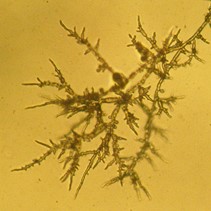
Version 11/5/2019
The first consideration for selecting an appropriate Phytophthora detection test is the number of plants to be tested. Use individual plant tests if only one or a few plants are to be tested. Individual plant tests are more efficient to conduct for small numbers of plants, especially plants that show symptoms that might be associated with Phytophthora root rot. For example, individual plant tests are appropriate for assessing the disease status of a few declining or dead plants in an otherwise healthy-looking batch. Individual plant tests are generally too time-consuming to use on large numbers of plants, so batch test methods are more appropriate for tests of many plants. Batch testing is useful for checking for the presence of cryptic Phytophthora infections in batches of plants that lack obvious symptoms. In some cases, it is appropriate to combine both types of tests. For example, when doing batch testing using the bench leachate method, any dead plants in the test batch should be removed and tested using individual plant tests.
Use the individual plant sampling/baiting (3.3) protocols to test one to a few plants with distinct symptoms.. When performed correctly, baiting is a sensitive test for many species of Phytophthora and can provide definitive positive results. False negative results can be obtained from baiting if infection levels are very low, but if selected plants are clearly symptomatic, detection efficency should be relatively high. Any of the three individual plant baiting methods can be used on live plants that are in relatively small containers, i.e., no larger than #1 (1 gal). For larger containers, including relatively tall containers such as Tree pots and larger DeePots, the leaching method will likely be the most efficient. If dead plants are being tested, use direct baiting of the entire plant root system, which is a destructive test, instead of the leaching or flooding protocols. For large dead plants, the entire root system may be too large for a single sample so you may need to divide it into several samples and/or sample only part of the root system.
Samples of one to a few plants can be submitted to a qualified lab for testing. For the CDFA lab, the local Agricultural Commissioner's office staff can be contacted to see if they will collect and ship the sample. Sample processing costs will vary depending on the tests that are run (e.g., direct isolation and/or immunoassay followed by PCR). If Phytophthora is not present in the plants, additional tests conducted by the CDFA or another qualified plant pathology diagnostic lab may be able to identify other pathogens that could be causing plant symptoms.
Given the limitations of currently available products, we have not found immunoassay test strips (3.1) to be especially useful for individual plant tests. These tests may be used to get an indication of whether Phytophthora is present in a symptomatic plant. However, each test can only use a very small amount of roots, which increases the likelihood of a false negative. Currently-available immunoassay test strips can generate both false negatives (from insufficient pathogen antigen in the small sample) and false positives (due to cross reaction with Pythium and Phytopythium species in the sample). A positive reaction in an immunoassay test is not definitive and requires followup testing by baiting or other methods to confirm the result. In contrast, a Phytophthora detection by baiting is conclusive and allows for identification of the pathogen species.
Use the bench leachate test method (3.4) to monitor batches of container-grown plants for in-nursery quality control purposes and predelivery testing. Prioritize testing to emphasize potentially symptomatic and other higher-risk plants, considering the risk factors in Table 1. The goal of quality control (QC) testing in the nursery is to sample throughout the nursery to detect any potential problems. However, QC nursery testing should also include material that is close to delivery to ensure that no Phytophthora is likely to be detected in any predelivery testing conducted by others. For predelivery testing, test as much of the material as is feasible, including tests of all species and batches if possible.
For testing purposes, a group of plants can be considered to be in the same batch if they have the same overall risk profile due to propagation history and location within the nursery. For example, two different seed sources of a given plant species that are propagated at the same time and are adjacent to each other on a bench could be considered as a single batch for testing purposes. In contrast, for a set of plants from a single seed source that was subsequently divided up and grown on separate benches, it would be logical to test plants from different benches (or different ends of a very long bench) separately.
If the purpose of baiting is to detect infected plants, the development of typical Phytophthora lesions on pear baits is sufficient to indicate that Phytophthora is present in the tested plants. If pear baits develop atypical lesions that do not match typical Phytophthora or Pythium lesions, it will be necessary to submit baits to a qualified lab for confirmation. To identify Phytophthora species present, symptomatic baits or cultures isolated from lesions on baits should be submitted to a qualified lab that can conduct DNA barcoding to match the isolate to known species.